Best Baldur's Gate 3 classes and tier list (post Patch 8)
The best BG3 classes and subclasses for 2025 are all here

The best Baldur’s Gate 3’s classes after Patch 8 haven't changed much, with our BG3 class tier list generally pretty unshakeable, but there are plenty of new options now that the patch has added a variety of new subclasses including boozy monks, magical snipers, and the option to give nerds swords. Clearly Larian understands the audience of Baldur’s Gate 3 well.
Our class guide to BG3 has absolutely everything players need to know, whether they're deciding on their preferred role for the first time or choosing how they want to respec class in Baldur’s Gate 3. We go into a full tier list laying out the best to worst, but we've also got beginner-friendly explanations of what the classes do, and all the various subclasses and specializations that they can take, to help you separate your valour bards from your glamour bards. If you want to know the best classes in all of Baldur's Gate 3, here's where you find out.
Best Baldur's Gate 3 classes and tier list

Our Baldur's Gate 3 class tier list breaks up into four tiers, best to worst. This list has been updated to reflect the state of the game in 2025, post-patch 8.
Picking the best Baldur's Gate 3 class for you is one of the most important choices you'll make, as this will determine your health, abilities, spells, the various Baldur's Gate 3 skills and most of your key character details.
The good news is that all the classes are good in some way and there are no truly 'bad' choices, but certain options are definitely better than others. That's largely because Dungeons and Dragons Fifth Edition - the TTRPG which this is all modelled on - has never managed to get its classes balanced out at an even power level - and Baldur's Gate 3 is no different.
Ultimately though, the class you pick should always be the one you like the most! Anything you pick is absolutely capable of making it through the game, all of them are fun to play, and the fact that you can choose from a pool of companions with different classes means that you can always arrange your party to fill in the various roles and abilities your character can't manage.
All Baldur's Gate 3 classes explained
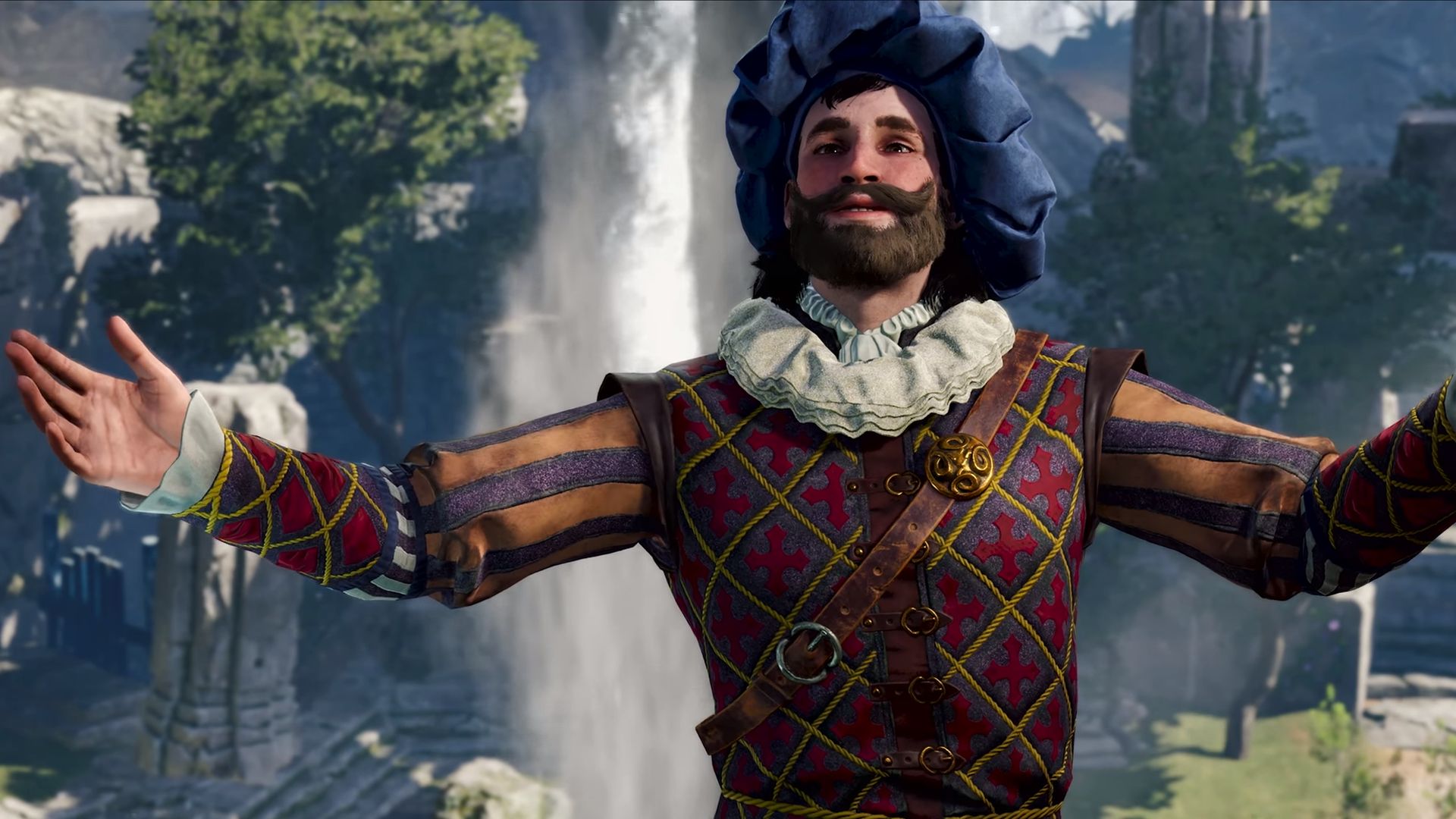
There are 12 classes in Baldur's Gate 3 currently:
- Barbarian: Tank and melee fighter, using Strength and Constitution.
- Bard: Support spellcaster and skills user, focused on Charisma and Dexterity.
- Cleric: Spellcaster whose powers vary depending on their god, but always uses Wisdom.
- Druid: Spellcaster capable of transformation, buffs and support, powered by Wisdom stat.
- Fighter: Diverse class that can be specced into any non-magical combat, using either Strength, Dexterity, Constitution, or any combination of the three.
- Monk: Unarmed warrior with great speed, mobility and no reliance on equipment - but does need high Dexterity and Wisdom.
- Paladin: Melee warrior, tank, healer and support class focused on Strength and Charisma.
- Ranger: Melee and ranged fighter with some support magic and utility skills fueled by Dexterity and Wisdom.
- Rogue: Dexterity-based stealth and skills user with a focus on high-damage strikes.
- Sorcerer: Charisma-powered glass-cannon spellcaster with an emphasis on raw firepower and abilities dependent on a special bloodline
- Warlock: Spellcaster with a versatile "jack of all trades" pool of charisma-based spells that vary according to their magical patron
- Wizard: Intelligence-based spellcaster who specialises in schools of magic and can learn more spells than any other class.
Clearly an important element here is having the right key attributes to match the class. A Sorcerer, for example, will ideally have a good Charisma score, as that's the core attribute that fuels their spells, while Constitution and Dexterity will help them avoid or negate damage to reduce their status as a glass cannon.
Still, there's enough complexity to classes, subclasses and how all their abilities intermingle to give you plenty of options
All Baldur's Gate 3 subclasses

We've got the full list of all Baldur’s Gate 3 subclasses below, as well as what level you get to pick these specializations, as it varies from class to class. Here are all the options currently available in the game:
- Barbarian subclasses (chosen at level 3)
- Berserker: Improve your rage powers to emphasise destructive force at your own risk.
- Path of Giants: Increase your strength and size to become a wall of muscle that can throw heavy objects.
- Wildheart: Channel animal power for primal abilities depending on what beast you align with.
- Wild Magic: Radiate random magical effects through your rage to all sorts of ends.
- Bard subclasses (chosen at level 3)
- College of Glamour: Use charm effects and illusory mind powers to bewitch opponents and support allies.
- College of Lore: Gain new spells, skills and ways to impact foes based on your education.
- College of Swords: Focus on your weapons to gain power in frontline combat and non-magical warfare.
- College of Valour: Gain new equipment proficiencies to survive in battle while buffing your allies attacks.
- Cleric subclasses (chosen at level 1)
- Death Domain: A necromancy cleric can wield dark magic to conjure corpses and use them to their benefit.
- Knowledge Domain: Learn divination and bewitching spells more aligned with wizardry, as well as improved skills.
- Life Domain: Heal, restore and support allies in what can be considered a classic cleric form.
- Light Domain: Channel powerful light and flame to burn and blind foes who get too close.
- Nature Domain: Touch on druidic powers to command flora and fauna while empowering allies.
- Tempest Domain: Summon thunder and lightning powers that tear through enemies at a distance.
- Trickery Domain: Use stealth, misdirection and roguish talents to navigate around enemies.
- War Domain: Gain equipment proficiencies and powers that support you in melee fighting.
- Druid subclasses (chosen at level 2)
- Circle of the Land: Gain new spells of your choice and the ability to regain spell slots on a short rest.
- Circle of the Moon: Empower your wild shape transformations to gain new forms and powers.
- Circle of the Spores: Use fungal powers to decay enemies and raise their corpses with necrotic power.
- Circle of the Stars: Channel constellations to gain Starry Form transformations that grant their own buffs and powers for different playstyles.
- Fighter subclasses (chosen at level 3)
- Arcane Archer: Combine magical power and sharpshooting to fire enchanted shots with different effects.
- Battle Master: Learn complex fighting maneuvers and techniques that allow you to control or impede opponents in combat.
- Champion: Focus on raw physicality to empower your attacks and hit as hard as possible.
- Eldritch Knight: Mix in some wizard spells to protect yourself and slay enemies even as you fight.
- Monk subclasses (chosen at level 3)
- Path of the Drunken Master: Become a liquor-fueled brawler who can restore Ki by drinking, inflict drunkenness on others, and generally live by the bottle.
- Path of the Four Elements: Use fire, air, water and earth powers to control the battlefield and gain more versatility.
- Path of the Open Hand: Have your unarmed attacks become greater than ever as you learn to detonate enemies' Ki when you strike them.
- Path of Shadow: Stealth and ninja-like abilities are mixed into your monk martial arts, allowing you to strike unaware foes.
- Paladin subclasses (chosen at level 1)
- Oath of Ancients: Nature power grants new buffs and support magics that help you protect the world.
- Oath of Devotion: A true shining knight, you focus on cleric-like support spells and healing, as well as means to smite undead and remove corrupion.
- Oath of the Crown: A lawful fighter focused on taunting enemies and taking damage instead of your allies.
- Oath of Vengeance: You pledge to destroy evil no matter what, and gain powers to better attack individual enemies who displease you.
- Oathbreaker: By forgoing your Oath, you gain both necromantic and damaging powers and spells themed around evil.
- Ranger subclasses (chosen at level 3)
- Beast Master: Summon an animal companion that aids you and gets more powerful over time.
- Gloom Stalker: Enhance your stealth and traversal to focus on more of a Rogue playstyle.
- Hunter: Learn various abilities to specialise in certain kinds of prey or combat.
- Swarmkeeper: Summon swarms of animals that you can send to hurt enemies and support you in combat.
- Rogue subclasses (chosen at level 3)
- Arcane Trickster: Mix some magical abilities into your skillset, largely focused on illusions and mind control.
- Assassin: Focus on damage from stealth to do slay opponents from ambush strikes.
- Swashbuckler: Use tricks to flourish in open melee, such as throwing sand or disarming opponents with a flick of your sword.
- Thief: Become a versatile crook with a lot of traversal powers and a free bonus action.
- Sorcerer subclasses (chosen at level 1)
- Draconic Bloodline: With the heritage of dragons, you wield elemental power and build your defenses.
- Shadow Magic Bloodline: You gain dark powers that let you use stealth, teleport, and summon eldritch minions.
- Storm Sorcery Bloodline: Embody the tempest as you wield electric shocks and concussive thunder, while also using the wind to move yourself and others.
- Wild Magic Bloodline: Pure chaos flows through you, allowing you to manipulate luck and generate unpredictable magical effects.
- Warlock subclasses (chosen at level 1)
- Archfey: A deal with a Fey spirit results in fairy tale or witchy powers, like mind enchantments and teleportation.
- Fiend: Selling your soul to a devil or demon grants fiery magic that dominates and destroys.
- Great Old One: Eldritch, alien forces have given you control of feeble mortal minds.
- Hexblade: Make a pact with the dark entities of the Shadowfell to create deadly melee weapons that curse and blight foes.
- Wizard subclasses (chosen at level 2)
- Bladesinging: A melee build who can enter an enhanced combat state that aids their defenses.
- School of Abjuration: These wizards focus on defense: shields, counterspells, protection and banishing foes.
- School of Conjuration: By summoning minions, objects and more, you fill the battlefield with helpful additions.
- School of Divination: You predict outcomes and even make them so, controlling dice results and discerning hidden information.
- School of Enchantment: This subclass uses mind control to confuse or even command enemies accordingly.
- School of Evocation: This school focuses on pure destruction and energy - fireballs, shockwaves, lightning and more.
- School of Illusion: Deceive others with false images or see through the ones they try to use against you.
- School of Necromancy: Death and undeath are controlled by these mages, who rot enemies away and then bring them back as obedient corpses.
- School of Transmutation: Transform and alter yourself and others, either to their benefit or disadvantage.
Let's take a more detailed look at all the Baldur's Gate 3 classes, including their tier rating, playstyle, attributes, pros and cons.
Barbarian
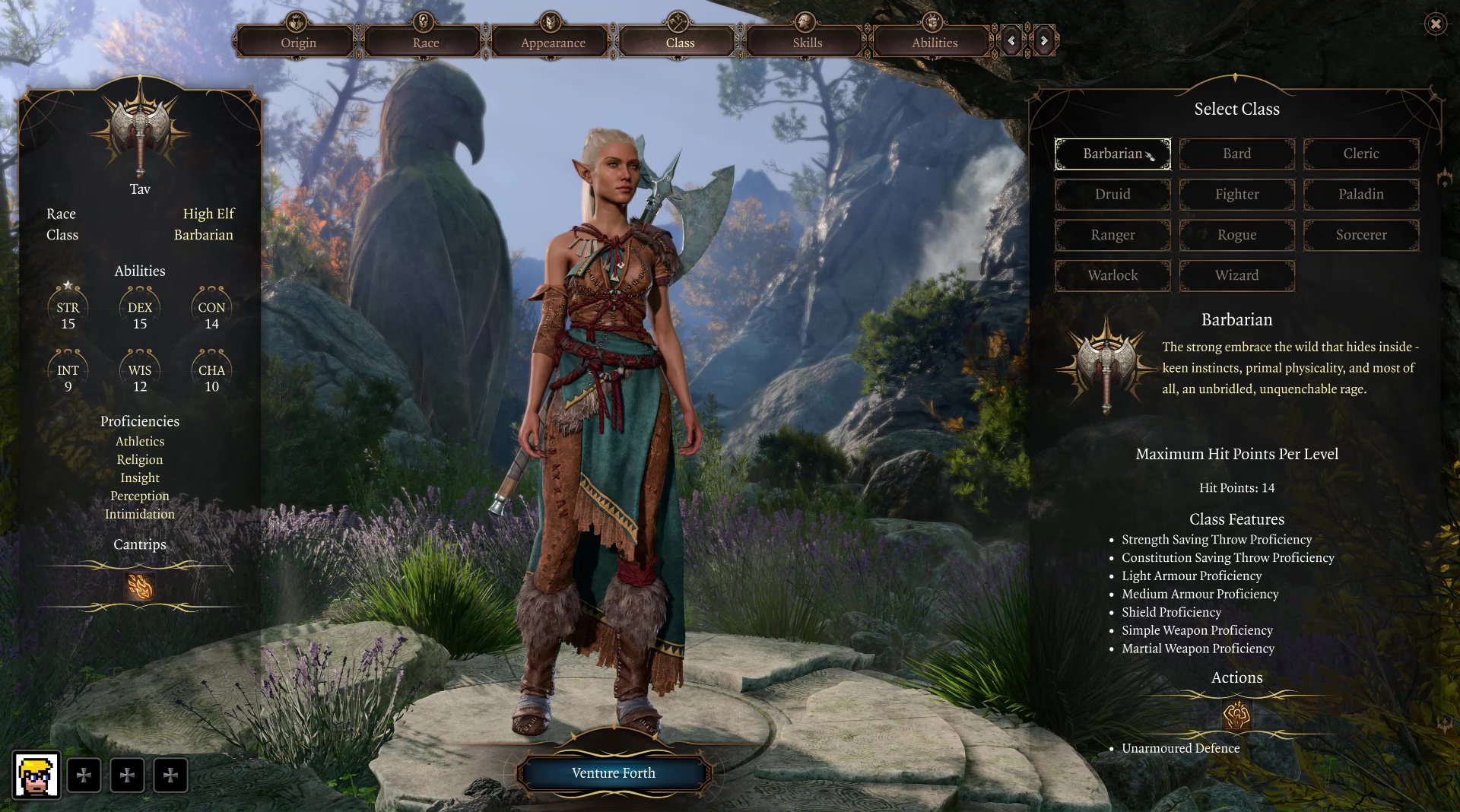
- Tier ranking: B
- Class type: Melee tank
- Primary Attributes: Strength, Constitution
- Secondary Attributes: Dexterity, Wisdom
- Pros: More health than any other class, good frontline power
- Cons: Few skills or ranged options
Baldur's Gate 3 Barbarians are similar to the Fighter, but more focused at the cost of versatility. They're great at fighting up front, Raging to gain bonuses, but struggle in any other context as they lack a huge amount of skills to fall back on. However, their high durability means they can take a real beating and live through most failures. Play aggressively - it's how they thrive.
Best Barbarian subclass: Berserker. The Berserker massively ramps up damage with the Frenzy ability, allowing you to make extra attacks and throws as bonus actions. It's not fancy, but it's very powerful.
Bard

- Tier ranking: S
- Class type: Charmer, support spellcaster and jack-of-all-trades skill user
- Primary Attributes: Charisma, Dexterity
- Secondary Attributes: Intelligence, Constitution
- Pros: Good all-rounder, very good at manipulation, something for any situation
- Cons: No massive firepower options
Bards are incredibly useful, and likeable, appropriately enough. One of several Charisma spellcaster classes, they have a variety of spells that support, heal and control, but have slightly better armor and health than sorcerers, so they're a little less risky to use in combat. Bards might not have any massively damaging magic, but they can often avoid fighting altogether with both physical and magical charm, or deducing an alternative path if you push into an Intelligence build. Pick from the Baldur's Gate 3 backgrounds carefully here, as these choices matter more for such skill-focused characters.
Best Bard subclass: College of Valor. We consider Valor superior as it's generally more useful to enhance your allies with Combat Inspiration than punish foes with Cutting Words - plus equipment proficiencies are probably better than the three skills you get.
Cleric
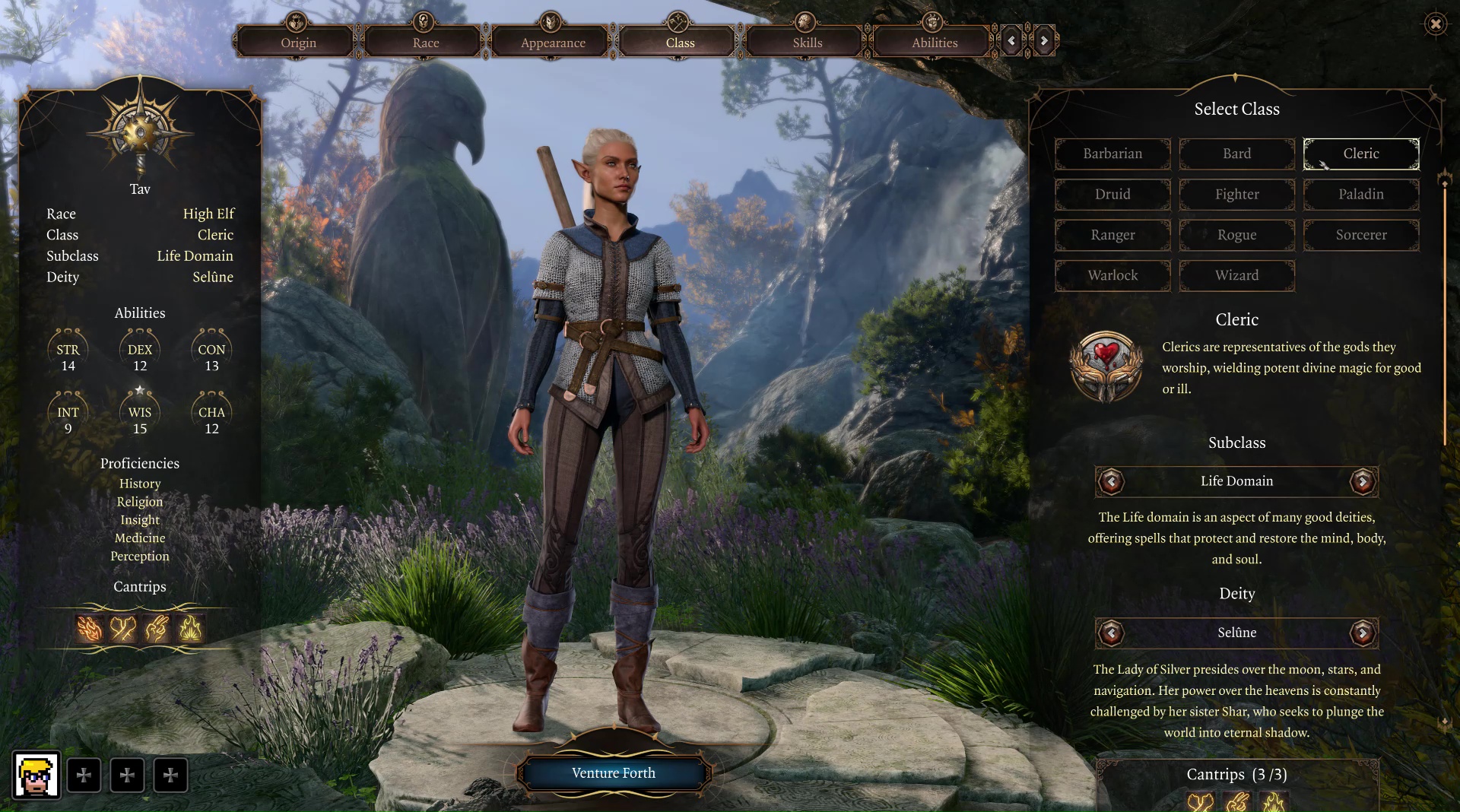
- Tier ranking: S
- Class type: God-powered spellcaster with a general support/heal focus
- Primary Attributes: Wisdom
- Secondary Attributes: Constitution, Strength
- Pros: Best healer, very flexible as a whole, some great spells
- Cons: Martial weapons would be nice, usual limitations of spell slots
Clerics were pretty broken in D&D 5E and they're broken here too: these spellcasters make for some of the best healers in the game, but also have the firepower and versatility to back it up. Not only that but they can also equip medium armor and shields making them a pretty potent class as a whole. The Guidance cantrip alone is a bit of a gamebreaker and one of the best Baldur's Gate 3 spells, adding a D4 to anything outside of combat. If there was one class that you could fill a party with and nothing else while still thriving, it'd probably be the Cleric.
Best Cleric subclass: Life Domain. It's a close call between this and the Light Domain, as frankly there's little reason to choose Trickery considering you've got Shadowheart in your party to fill that role. The Life Domain boosts healing which is the main point of having a Cleric and it grants heavy armor proficiency, which can be great if you didn't put much into the character's Dexterity.
Druid

- Tier ranking: B
- Class type: Support, control and utility spellcaster based on all things natural
- Primary Attributes: Wisdom
- Secondary Attributes: Constitution, Dexterity
- Pros: Not too dependant on spells, Wild Shape rules
- Cons: Not as much offensive power as you'd hope
Druids basically have two tricks - an array of nature spells and Wild Shape, which lets you transform into animals. It's an incredibly versatile power that also lets you play tank with little risk because you don't share hit points with your humanoid form and just turn back to normal if your animal shape gets KO'd. The Druid also has a good selection of spells, but aside from a few notable standouts, like Shillelagh and Heat Metal, the versatility has to make up for any real punch.
Best Druid subclass: Circle of the Moon. Wild Shape is incredibly useful and powerful, so just double down on it. Circle of the Moon is all about enhancing your Wild Shape, giving it more options and elasticity. Circle of the Land is fine, but it's no substitute for turning into a Polar Bear and drawing aggro to a body that isn't even yours.
Fighter
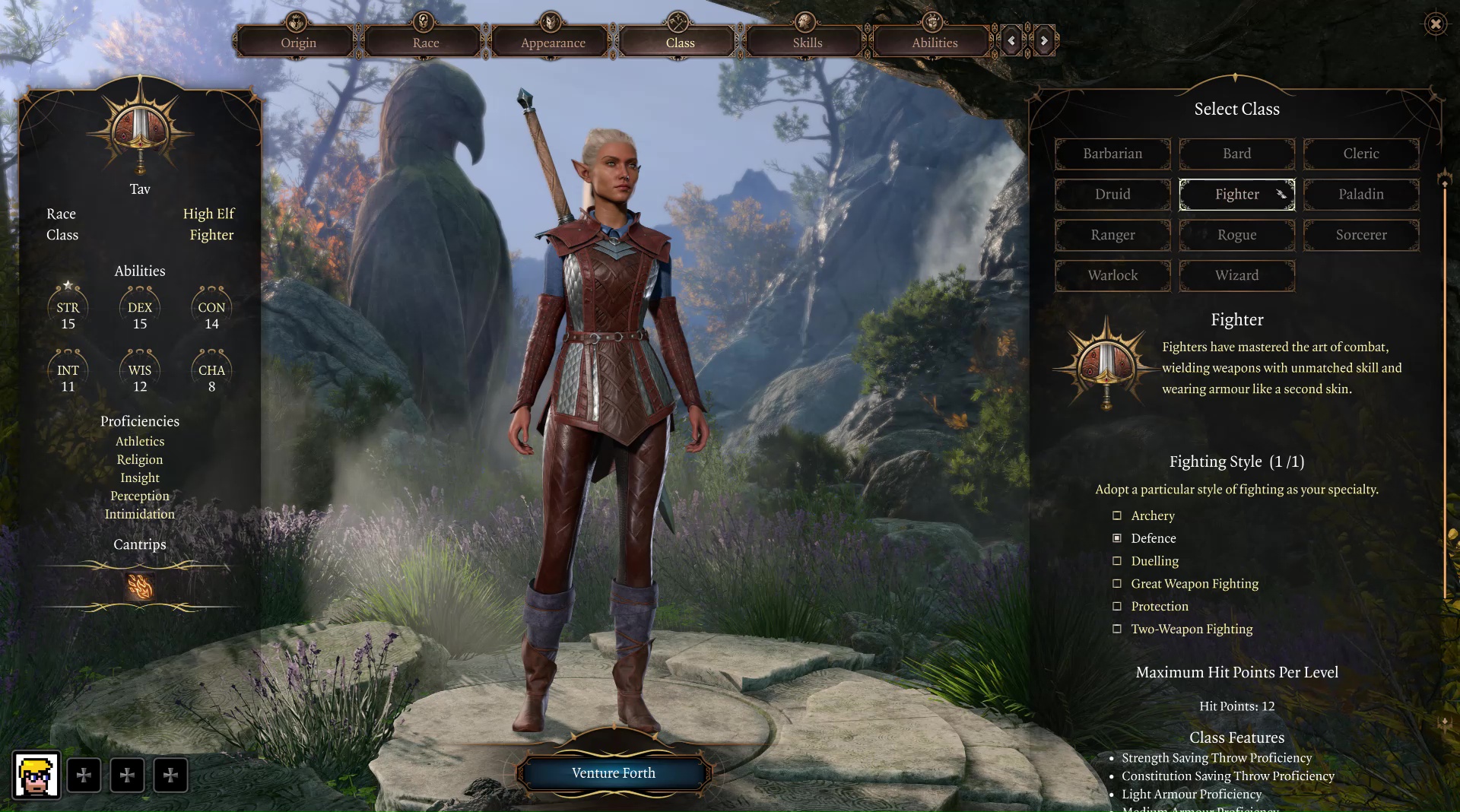
- Tier ranking: B
- Class type: A blank check for non-magical combat with any weapon or armor
- Primary Attributes: Strength, Dexterity, Constitution
- Secondary Attributes: Wisdom
- Pros: Tough, able to use any weapon or armor
- Cons: Bit boring, not especially good out of combat
The Fighter is basically a generic choice that allows for any build of weapons and armor, depending on what you make. You should pick either Strength or Dexterity at the start and work from there, focusing either on one or the other. Fighters are dependable in combat, and Action Surge is nice, but outside a fight they're a bit flimsy and lacking in real contributions. Considering you already have a Fighter in your party with Lae'zel, you should probably pick something else.
Best Fighter subclass: Battle Master. Battle Master is more versatile than the spellcasting Eldritch Knight option, as it gives you a ton of powerful combat abilities. We suggest picking Riposte, Pushing Attack and Disarming Attack, which will give you something for everything.
Monk

- Tier rank: A
- Class type: A martial arts powerhouse who doesn't need to rely on weapons or equipment, using high mobility and unarmed strikes.
- Primary Attributes: Dexterity, Wisdom
- Secondary attributes: Strength, Constitution
- Pros: Strong unarmed attacks, less reliance on main weapon, can deflect missiles and send them back to source
- Cons: Poor at ranged attacks, poor party healing, difficult to do heavy damage
The Monk is a decent choice if you favor methodical and planned bursts of attack over all-out brutality. Similar to Rogues, Monks work well from close proximity when they have the element of surprise on their side. With little in the way of innate ranged attack strength at your disposal, you can choose to focus your ki in various ways to help reach those more distant targets. Wood half-elves make decent Monks, thanks to a shared proclivity for moving quickly and being light on one's feet. Basically, this is a class about running around quickly and punching people - who could object?
Best subclass: Way of the Open Hand. The Resonating Ki power given to this subclass later on is a complete game-changer, allowing you to trigger unstable elements in enemies you punch, causing a chain reaction of deadly shockwaves across the battlefield and wiping out whole armies. Even before that though, Open Hand monks can imbue their punches with special damage types, and throw enemies around in a way similar to the Fighter Battle Master maneuverers.
Paladin
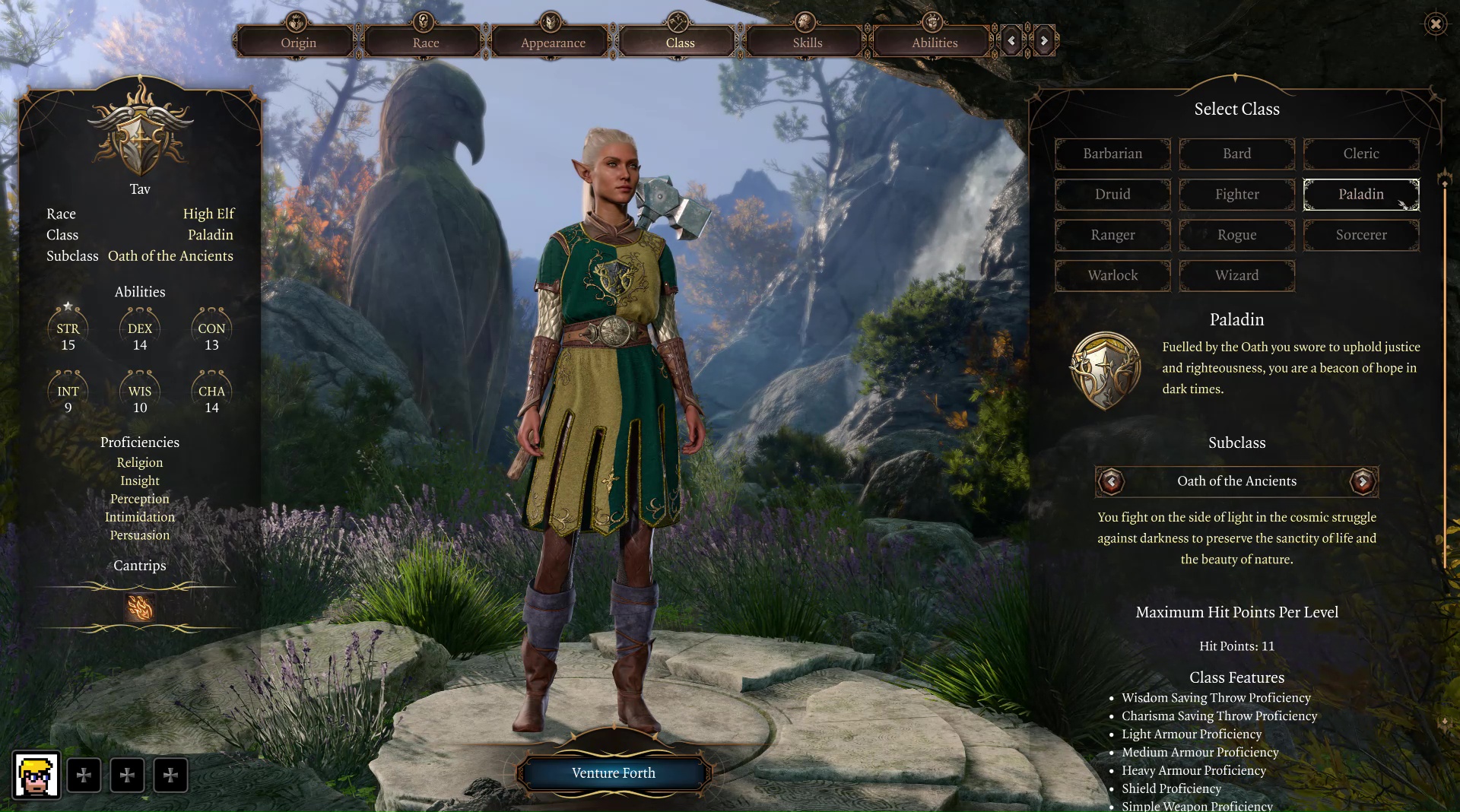
- Tier ranking: A
- Class type: Charisma spellcaster, healer and melee tank
- Primary Attributes: Strength, Charisma
- Secondary Attributes: Constitution, Wisdom
- Pros: Charisma, support options and healing, limitless equipment options
- Cons: No real ranged or massive firepower options, spells are limited
Paladins are a lot of fun, and a good alternative to a Cleric. They have a wide range of uses, including melee tanks, and are capable frontline warriors who can throw out magic to heal, support and control a battle, or just obliterate foes. On top of all that, their Charisma means that they still serve a role outside of fighting as good-looking charmers.
Best Paladin subclass: Oath of the Ancients. It's another close call, but Oath of the Ancients is a little more versatile, and the addition of a short-range teleport with Misty Step at 5th level is something that many classes would be jealous of. Still, for a more focused build, the Oath of Vengeance is a powerhouse choice.
For more info, find out the best Baldur's Gate 3 Paladin build here.
Ranger
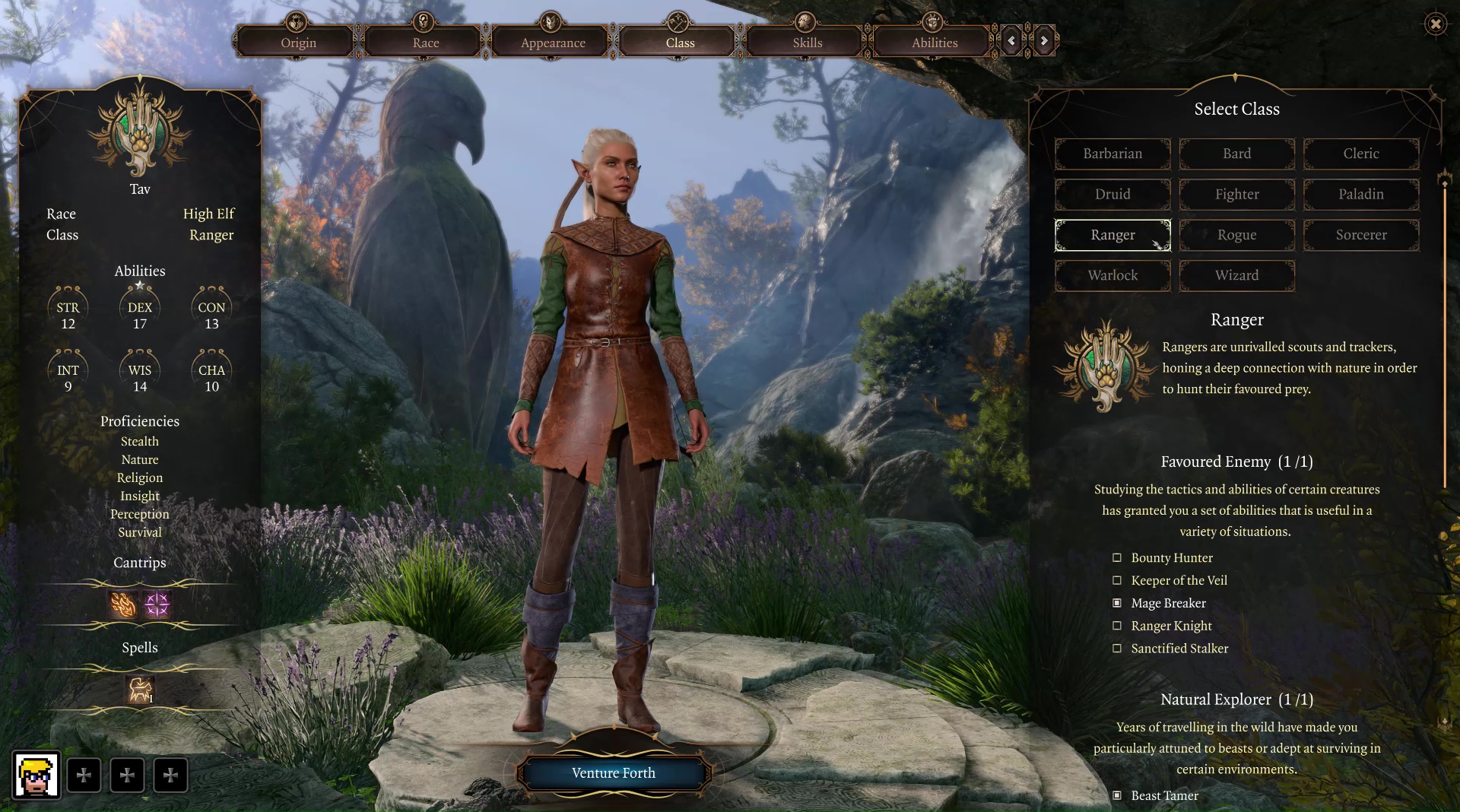
- Tier ranking: C
- Class type: Utility attacker who specialises in certain approaches
- Primary Attributes: Dexterity, Wisdom
- Secondary Attributes: Constitution, Strength
- Pros: High health, some variation in builds
- Cons: Not exceptional at anything
Rangers aren't phenomenal because while they have a range of abilities to choose from - things like a Favoured Enemy, Natural Explorer and Fighting Style - they're all mostly a lot of small, occasionally fun gimmicks that don't really rock the boat or stand out. Dexterity is your bread and butter here, as the pool of spells you unlock at level 2 is small and quite situational, making them a bonus to your class rather than an integral part of it. You should probably check out how to dual wield in Baldur's Gate 3, as it's a classic build for Rangers.
Best Ranger subclass: Swarmkeeper. Added in Patch 8, the bees, butterflies and jellyfish you can summon prove themselves surprisingly helpful, especially when you start becoming able to use them to fly.
Rogue
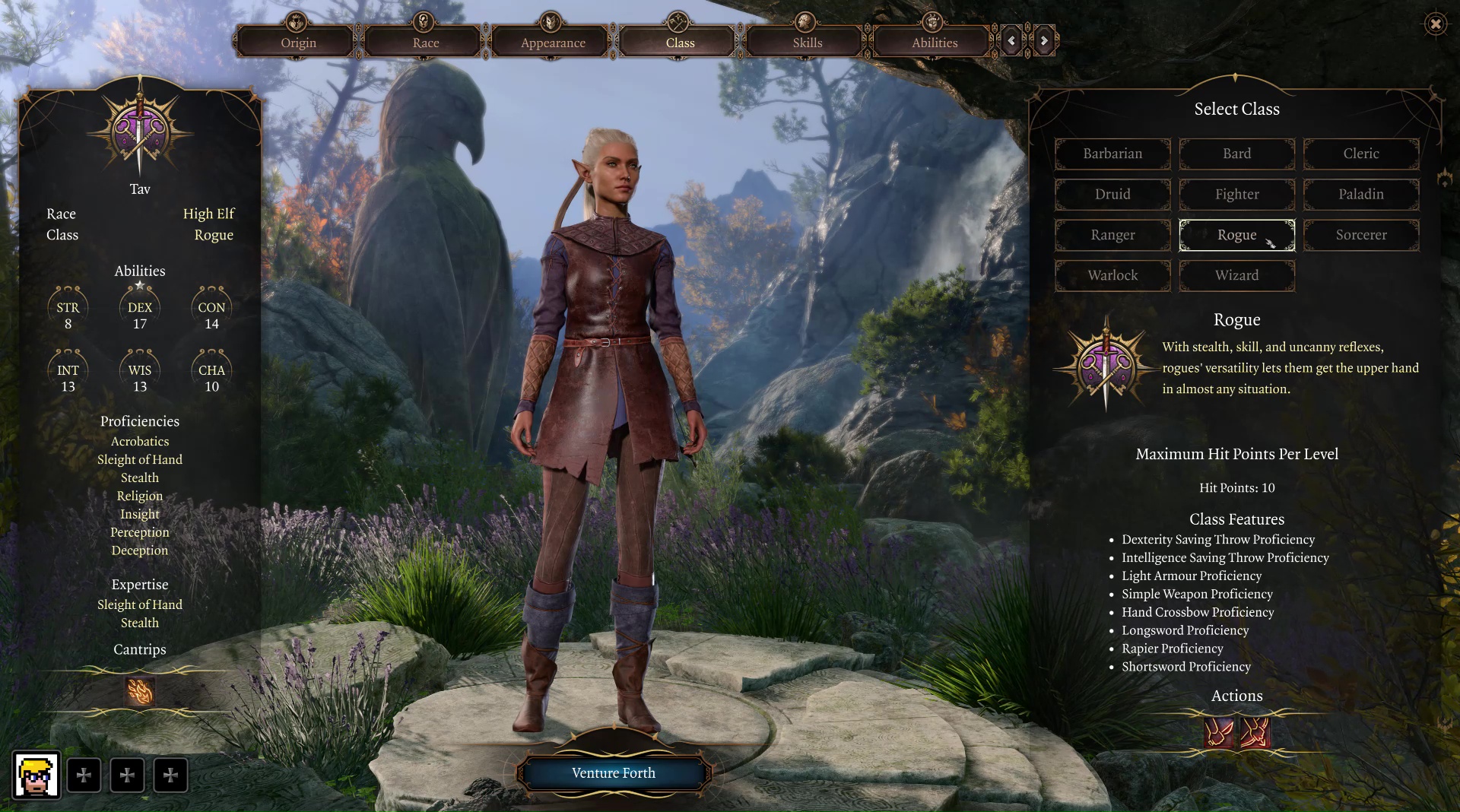
- Tier ranking: B
- Class type: A skills-and-stealth sneaker who does high-damage targeted strikes
- Primary Attributes: Dexterity
- Secondary Attributes: Intelligence, Wisdom, Charisma
- Pros: Lot of skills, high mobility, sneak attack hits often
- Cons: Risky and somewhat situational
Rogues are tricky because they're really good until they're really not (and weaker than rogues in 5e). Their high mobility is good, using Cunning Action to dash about at speed, but their sneak attack isn't as deadly as it used to be, and failing to kill means you'll have your low-health, low-armor assassin suddenly in peril. Plus, while all those skills are nice, rogues are designed to scout ahead, which is always a risky thing - we all know the perils of splitting the party.
Best Rogue subclass: Swashbuckler. The powers of the Patch 8 subclass are great, especially the ability to hit Sneak Attacks without needing disadvantage. However, because the Swashbuckler's powers scale to Charisma, it doesn't suit the less charming Astarion's stats - instead, you should make him a Thief, which is a close second in terms of great subclasses.
Sorcerer
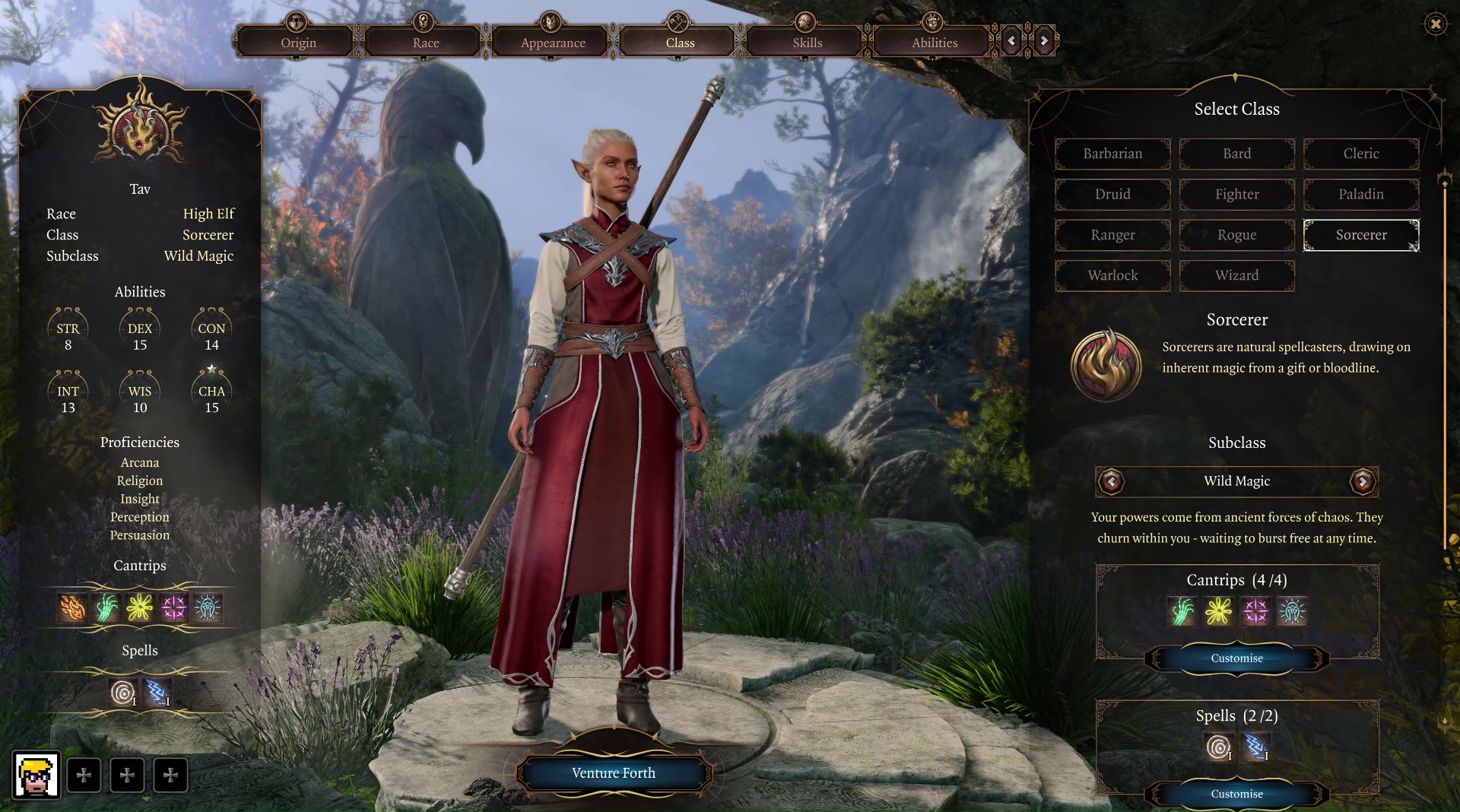
- Tier ranking: A
- Class type: A glass-cannon spellcaster focused on high damage and spell modification
- Primary Attributes: Charisma
- Secondary Attributes: Constitution, Dexterity
- Pros: Massive damage output, spell metamagic can be very helpful, charisma is a good stat to build around
- Cons: No defences, no weapon skills
The Sorcerer gains power from an inherited bloodline, which makes them more focused and less versatile than their cousin class, the Wizard. Having your spells derive from Charisma is great, as it means you can also pull dual-roles as the group's "Face". The ability to modify your spells with Metamagic also means you can gain more from the spells you have. However, the obvious failing is that with no armor and low health you're about as tough as a breadstick - and you also can't use any but the most basic weapons on offer, and not especially well.
Best Sorcerer subclass: Draconic Bloodline. Wild Magic is arguably more fun, but it's far too chaotic to be reliable, as the random effects can play against you as much as for you. Draconic Bloodline spikes your survivability, granting you a better armor class and health score, as well as some extra bonuses depending on the type of dragon you choose (we recommend either White or Red).
Warlock
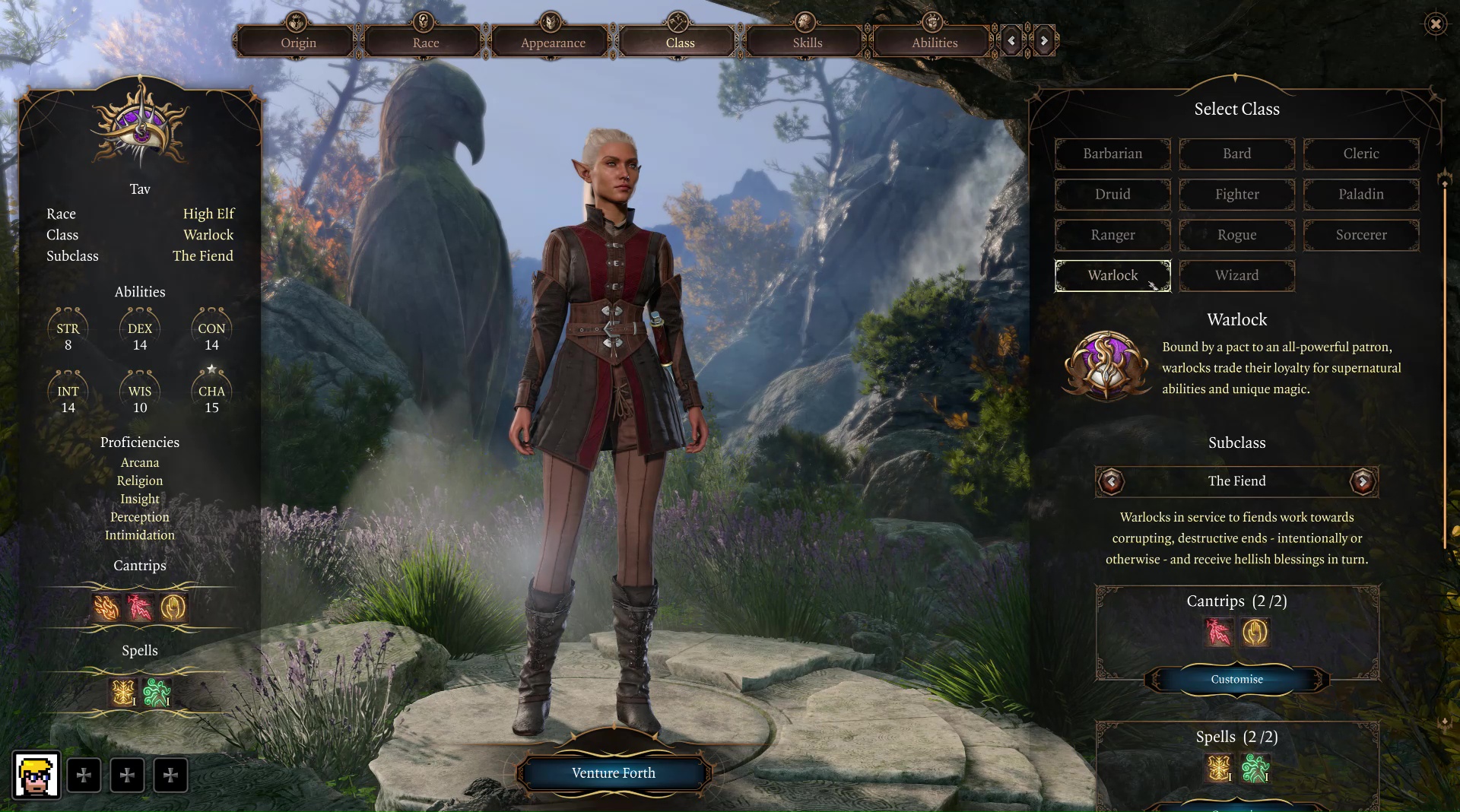
- Tier ranking: A
- Class type: A versatile spellcaster with tricks for any situation
- Primary Attributes: Charisma
- Secondary Attributes: Constitution, Dexterity
- Pros: A bag of tricks who can play to any situation, short rest refreshes
- Cons: Master of none, often runs low on spell slots
The Warlock is a magical counterpart to the Rogue; a class with something for any situation, but lacking any real speciality. They've got medium armor, medium health, medium weapon capabilities, medium spells (though a diverse range to pick from), and while you have less spell slots than most, they refresh on a short rest rather than a long one. Plus, as before, being a charisma spellcaster means you can also be a good negotiator, which is always worth having. Choose a few fun Invocations and you'll have a solid character who can thrive on their own as much as in the group.
Best Warlock subclass: The Hexblade. The emphasis on frontline fighting made an option in Patch 8 somehow doesn't penalize spellcasting power, meaning that Warlocks get an across-the-board enhancement. The fact that they also get new equipment proficiencies effectively turns them into dark knights with few equals.
Wizard

- Tier ranking: A
- Class type: A pure spellcaster who can learn additional spells along the way.
- Primary Attributes: Intelligence
- Secondary Attributes: Constitution, Dexterity
- Pros: Flexible damage dealer who rarely runs out of magic
- Cons: When you DO run out of magic, you're in trouble. Plus you're squishy
The Wizard is to magic what the Fighter is to equipment - a blank check to do almost anything magical bar healing. Wizards are glass cannons like the Sorcerers, but where Sorcerers are focused on particular spell types, Wizards are far more versatile, with a bigger spell list and Arcane Recovery that allows Spell Slot regeneration. Plus, they can learn new spells permanently by spending 50gp over a spell scroll - a huge bonus that the game doesn't play up enough.
Best Wizard subclass: School of Evocation. Conjuration spells are often more the meta for wizards - summoning disposable minions who draw aggro and weigh the action economy on your side - but you can do this without needing the Conjuration school. Evocation allows you to throw damaging AOE spells without hurting your allies, and boosts the damage of your spells over time.
© GamesRadar+. Not to be reproduced without permission
Weekly digests, tales from the communities you love, and more

Joel Franey is a writer, journalist, podcaster and raconteur with a Masters from Sussex University, none of which has actually equipped him for anything in real life. As a result he chooses to spend most of his time playing video games, reading old books and ingesting chemically-risky levels of caffeine. He is a firm believer that the vast majority of games would be improved by adding a grappling hook, and if they already have one, they should probably add another just to be safe. You can find old work of his at USgamer, Gfinity, Eurogamer and more besides.
- Jasmine Gould-WilsonStaff Writer, GamesRadar+
- Aimee HartContributor
You must confirm your public display name before commenting
Please logout and then login again, you will then be prompted to enter your display name.


